
Coconut Grove, also known colloquially as “The Grove,” is an affluent and the oldest continuously inhabited neighborhood of Miami in Miami-Dade County, Florida. The neighborhood is roughly bounded by North Prospect Drive to the south, LeJeune Road to the west, South Dixie Highway and Rickenbacker Causeway to the north, and Biscayne Bay to the east. It is south of the neighborhoods of Brickell and The Roads and east of Coral Gables. The neighborhood's name has been sometimes spelled "Cocoanut Grove" but the definitive spelling "Coconut Grove" was established when the city was incorporated in 1919.
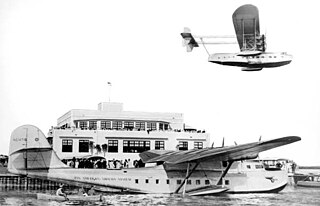
Dinner Key is a marina complex in the Coconut Grove neighborhood of Miami, Florida, along the shore of Biscayne Bay on South Bayshore Drive. It was originally an island, but was connected to the mainland in 1914 by filling in the intervening space. An early source attributes the name to the island being a convenient place to stop to eat while traveling by boat between the mouth of the Miami River and Snapper Creek south of Miami. Dinner Key is accessible by public transit via the Coconut Grove Circulator from the Miami Metrorail at Coconut Grove and Douglas Road stations. Formerly, it has been the location of Coast Guard Air Station Dinner Key and International Pan American Airport.

Florida State Road 9 (SR 9) is a state road in the U.S. state of Florida. While SR 9 is mainly used as a state designation for Interstate 95 in Florida from the Golden Glades Interchange in Miami Gardens to the Georgia border, a signed SR 9, which is locally known in the Miami area as West 27th Avenue, Unity Boulevard, and historically Grapeland Boulevard, extends 13 miles (21 km) from the Coconut Grove section of Miami to the Golden Glades Interchange. The segment of I-95 south of the Golden Glades Interchange carries the designation of State Road 9A.

Downtown Miami is the urban city center of Miami, Florida, United States. The city's greater downtown region consists of the Central Business District, Brickell, the Historic District, Government Center, the Arts & Entertainment District, and Park West. It is divided by the Miami River and is bordered by Midtown Miami's Edgewater, and Wynwood sections to its north, Biscayne Bay to its east, the Health District and Overtown to its west, and Coconut Grove to its south.

Miami Avenue is a 16.8-mile (27.0 km) main north–south street running through Coconut Grove, Brickell, Downtown, and Midtown in Miami, Florida. It is the meridian road dividing the street grid of Miami and Miami-Dade County into east and west avenues.

The Snell Arcade is a historic site in St. Petersburg, Florida. The building was designed by the architect Richard Kiehnel of Kiehnel and Elliott. Built in 1926, it is located at 405 Central Avenue. On November 4, 1982, it was added to the U.S. National Register of Historic Places. The Snell Arcade was developed by C. Perry Snell, a wealthy landowner and philanthropist.

The Old U.S. Post Office and Courthouse is a historic courthouse in Miami, Florida. It is located at 100-118 Northeast 1st Avenue. Constructed over three years (1912–14), it was designed by Kiehnel and Elliott and Oscar Wenderoth. It was added to the U.S. National Register of Historic Places on January 4, 1989. The Miami-Dade County Tax Records say this building was built in 1917 .

El Jardin is a house located at 3747 Main Highway in Miami, Florida. It is listed on the U.S. National Register of Historic Places. El Jardin is now home to Carrollton School of the Sacred Heart in Miami, Florida. It was added to the U.S. National Register of Historic Places on August 30, 1974.

Miami Senior High School, also known as Miami High School, is a public high school located at 2450 SW 1st Street in Miami, Florida, and operated by Miami-Dade County Public Schools. Founded in 1903, it is one of the oldest high schools in Miami-Dade County. The school building is famous for its architecture and is a historic landmark. Miami Senior High School has a rich alumni base, with many graduates of the high school going on to varied, prominent careers. The high school originally served the earliest settling families of Miami in the first half of the 20th century. By the late 1960s, with an increase in Miami's population, its student body grew at a fast pace.
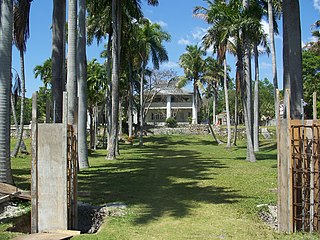
The Trapp Homestead is a historic home in the Coconut Grove section of the City of Miami, Florida, United States. It is located at 2521 South Bayshore Drive. On November 10, 1994, it was added to the U.S. National Register of Historic Places. The home was constructed in 1887 out of oolitic lime quarried locally by Caleb Trapp and his son, Harlan. During construction, the Trapps lived on a thatched hut at the front of the property. The property is believed to be the oldest-standing masonry home in Miami-Dade County, Florida. The estate's construction pre-dates the incorporation of the City of Miami. The estate was particularly notable at the time because it was one of the few stone structures in Miami-Dade County, as nearly all structures in the area were built of wood at that time.
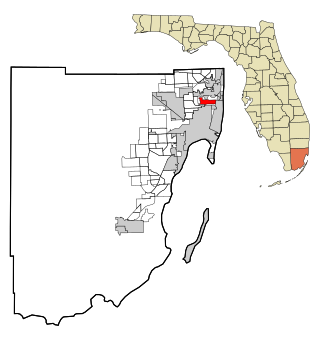
The Miami Shores Thematic Resource — in Miami Shores, Miami-Dade County, Florida
Alfred Browning Parker, FAIA was a Modernist architect who is one of the best-known post World War II residential architects. He gained fame for his highly published modern houses in the region around Miami, Florida. He was born in Boston, MA and moved to Miami when he was eight years old. Parker graduated from the University of Florida in 1939 with a degree in Architecture. Influenced by Frank Lloyd Wright but with regional touches, Parker's designs have been published in many magazines such as House Beautiful, as well as in companion books.

The Coconut Grove Playhouse was a theatre in the Coconut Grove neighborhood of Miami, Florida, United States. The building was originally constructed as a movie theater called the Player's State Theater. It opened on January 1, 1927, as a part of the Paramount chain. The movie house was designed by the architect Richard Kiehnel of Kiehnel and Elliott. It was built by local realtors Irving J. Thomas and Fin L. Pierce. Albert Peacock was the contractor.
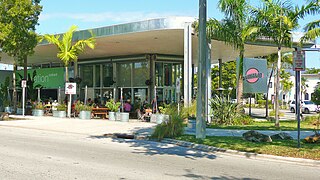
The Upper Eastside is a neighborhood in Miami, Florida. It is north of Edgewater, east of Little Haiti, south of the village of Miami Shores, and sits on Biscayne Bay. In geographical order from south to north and east to west, it contains the subdivisions of Magnolia Park, Bay Point, Morningside, Bayside, Belle Meade, Shorecrest, and Palm Grove. The MiMo District along Biscayne Boulevard in the area is host to many art galleries, shops and restaurants.
Robert Law Weed (1897–1961) was an architect from Miami, Florida. He designed many Modernist buildings in Miami and abroad.

Buena Vista is a neighborhood in Miami, Florida, United States. It is located south of Little Haiti, north of the Miami Design District.
Eastern Shores is a neighborhood within the city of North Miami Beach in Miami-Dade County, Florida, United States. It is located about 12 miles (19 km) north of Miami, just south of the city of Aventura.
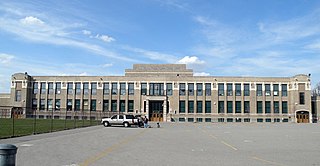
Greenfield Elementary School is a historic school in the Greenfield neighborhood of Pittsburgh, Pennsylvania. The school was designed by the firm of Kiehnel and Elliott and opened in 1922. It is part of the Pittsburgh Public Schools district and serves students in Pre-K through 8th grade.
Martin Luther Hampton was an architect in Florida. After studying at the Columbia University in New York he settled in 1914 in Miami. Many of his buildings are listed on the National Register of Historic Places.

















